Operation Risk Simulation and Interaction Impact of Stormwater and Sewage Systems Based on Storm Water Management Model
Abstract
:1. Introduction
2. Materials and Methods
2.1. Study Area
2.2. Urban Drainage Pipe Network Hydraulic Modeling
2.2.1. Stormwater Drainage System Modeling
2.2.2. Sewage Drainage System Modeling
2.2.3. Coupled Simulation for Stormwater and Sewage Pipe Networks
2.2.4. Model Calibration
2.3. Drainage Pipe Network Risk Assessment
3. Results
3.1. Risks of Stormwater Drainage System in Rain Scenario
3.1.1. Analysis of Full-Load and Overload Pipes
3.1.2. Analysis of Node Overflow
3.2. Risks of Stormwater Drainage System in Rain-Sewage Scenario
3.2.1. Analysis of Full-Load and Overload Pipes
3.2.2. Analysis of Node Overflow
3.3. Risks of Sewage Drainage System in Dry Weather Scenario
3.3.1. Analysis of Full-Load and Overload Pipes
3.3.2. Analysis of Node Overflow
3.3.3. Analysis of Low Velocity
3.4. Risks of Sewage Drainage System in Rainy Weather Scenario
3.4.1. Analysis of Full-Load and Overload Pipes
3.4.2. Analysis of Node Overflow
3.4.3. Analysis of Low Velocity
4. Discussion
4.1. Risk of Drainage Network
4.2. Impact of Stormwater Inflow on the Operational Risks of Sewage Drainage System
4.3. Impact of Sewage Inflow on the Operational Risks of Stormwater Drainage System
5. Conclusions
Author Contributions
Funding
Data Availability Statement
Conflicts of Interest
References
- Zhang, Y. Study on Risk Assessment in Operation of Urban Drainage Network. Urban Roads Bridges Flood Control. 2022, 6, 104–109. [Google Scholar] [CrossRef]
- Waters, D.; Watt, W.E.; Marsalek, J.; Anderson, B.C. Adaptation of a Storm Drainage System to Accommodate Increased Rainfall Resulting from Climate Change. J. Environ. Plan. Manag. 2003, 46, 755–770. [Google Scholar] [CrossRef]
- Lin, J.; He, P.; Yang, L.; He, X.; Lu, S.; Liu, D. Predicting Future Urban Waterlogging-Prone Areas by Coupling the Maximum Entropy and FLUS Model. Sustain. Cities Soc. 2022, 80, 103812. [Google Scholar] [CrossRef]
- Alfonso, L.; Mukolwe, M.M.; Di Baldassarre, G. Probabilistic Flood Maps to Support Decision-Making: Mapping the Value of Information. Water Resour. Res. 2016, 52, 1026–1043. [Google Scholar] [CrossRef]
- Jato-Espino, D.; Lobo, A.; Ascorbe-Salcedo, A. Urban Flood Risk Mapping Using an Optimised Additive Weighting Methodology Based on Open Data. J Flood Risk Manag. 2019, 12, e12533. [Google Scholar] [CrossRef]
- Joseph-Duran, B.; Jung, M.N.; Ocampo-Martinez, C.; Sager, S.; Cembrano, G. Minimization of Sewage Network Overflow. Water Resour Manag. 2014, 28, 41–63. [Google Scholar] [CrossRef]
- Yin, H.; Lu, Y.; Xu, Z.; Li, H.; Schwegler, B.R. Characteristics of the Overflow Pollution of Storm Drains with Inappropriate Sewage Entry. Env. Sci. Pollut. Res. 2017, 24, 4902–4915. [Google Scholar] [CrossRef]
- Wang, H.; Lei, X.; Khu, S.-T.; Song, L. Optimization of Pump Start-Up Depth in Drainage Pumping Station Based on SWMM and PSO. Water 2019, 11, 1002. [Google Scholar] [CrossRef]
- Lee, J.; Chung, G.; Park, H.; Park, I. Evaluation of the Structure of Urban Stormwater Pipe Network Using Drainage Density. Water 2018, 10, 1444. [Google Scholar] [CrossRef]
- Shamseldin, A.Y.; Wotherspoon, L.; Raith, A. Indicator-Based Resilience Assessment of Stormwater Infrastructure Network Structure. Urban Water J. 2023, 1–12. [Google Scholar] [CrossRef]
- Du, W.; Gong, Y.; Chen, N. PSO-WELLSVM: An Integrated Method and Its Application in Urban Waterlogging Susceptibility Assessment in the Central Wuhan, China. Comput. Geosci. 2022, 161, 105079. [Google Scholar] [CrossRef]
- Xu, H.; Wang, Y.; Fu, X.; Wang, D.; Luan, Q. Urban Flood Modeling and Risk Assessment with Limited Observation Data: The Beijing Future Science City of China. Int. J. Environ. Res. Public Health 2023, 20, 4640. [Google Scholar] [CrossRef] [PubMed]
- Wang, P.; Li, Y.; Yu, P.; Zhang, Y. The Analysis of Urban Flood Risk Propagation Based on the Modified Susceptible Infected Recovered Model. J. Hydrol. 2021, 603, 127121. [Google Scholar] [CrossRef]
- Pan, X.; Yu, H.; Wang, L. Waterlogging risk analysis method based on variable fuzzy clustering model. Water Resour. Plan. Des. 2023, 8, 32–35. [Google Scholar]
- Baah, K.; Dubey, B.; Harvey, R.; McBean, E. A Risk-Based Approach to Sanitary Sewer Pipe Asset Management. Sci. Total Environ. 2015, 505, 1011–1017. [Google Scholar] [CrossRef] [PubMed]
- Song, R.; Guo, Y.; Xu, W.; Wang, X.; Ci, S.; Zheng, Y.; Han, D.; Fan, D. Application on sewage pipe network operation management with InfoWorks ICM. Water Wastewater Eng. 2022, 58, 401–405. [Google Scholar] [CrossRef]
- Li, D.; Cong, A.; Guo, S. Sewer Damage Detection from Imbalanced CCTV Inspection Data Using Deep Convolutional Neural Networks with Hierarchical Classification. Autom. Constr. 2019, 101, 199–208. [Google Scholar] [CrossRef]
- Cheng, J.C.P.; Wang, M. Automated Detection of Sewer Pipe Defects in Closed-Circuit Television Images Using Deep Learning Techniques. Autom. Constr. 2018, 95, 155–171. [Google Scholar] [CrossRef]
- Dang, L.M.; Hassan, S.I.; Im, S.; Mehmood, I.; Moon, H. Utilizing Text Recognition for the Defects Extraction in Sewers CCTV Inspection Videos. Comput. Ind. 2018, 99, 96–109. [Google Scholar] [CrossRef]
- Peche, A.; Graf, T.; Fuchs, L.; Neuweiler, I. Physically Based Modeling of Stormwater Pipe Leakage in an Urban Catchment. J. Hydrol. 2019, 573, 778–793. [Google Scholar] [CrossRef]
- Wirahadikusumah, R.; Abraham, D.M.; Iseley, T.; Prasanth, R.K. Assessment Technologies for Sewer System Rehabilitation. Autom. Constr. 1998, 7, 259–270. [Google Scholar] [CrossRef]
- Cao, M.; Sun, Z.; Zhang, L.; Yan, S.; Fan, H. Research on Optimization of Safe Water Delivery and Water Quality Control of Sewage System Based on Integrated Catchment Management (ICM). Fresenius Environ. Bull. 2022, 30, 12891–12897. [Google Scholar]
- Yu, C.; Li, P.; Zhang, H.; Fan, L.; Li, J. Yiliang He Evaluation of Diversion Capacity of Sewage Pipeline Network and Optimization of Drainage Capacity of Pump Station Based on Infoworks ICM Model. Water Purif. Technol. 2019, 38, 60–67. [Google Scholar] [CrossRef]
- Agonafir, C.; Lakhankar, T.; Khanbilvardi, R.; Krakauer, N.; Radell, D.; Devineni, N. A Review of Recent Advances in Urban Flood Research. Water Secur. 2023, 19, 100141. [Google Scholar] [CrossRef]
- Perry, W.B.; Ahmadian, R.; Munday, M.; Jones, O.; Ormerod, S.J.; Durance, I. Addressing the Challenges of Combined Sewer Overflows. Environ. Pollut. 2024, 343, 123225. [Google Scholar] [CrossRef] [PubMed]
- Wambecq, T.; Kroll, S.; Van Assel, J.; Delgado, R. CSO Generator—A Parsimonious Wastewater Quality Model for Combined Sewer Overflows. Water 2023, 15, 3424. [Google Scholar] [CrossRef]
- Lyu, H.-M.; Wang, G.-F.; Shen, J.; Lu, L.-H.; Wang, G.-Q. Analysis and GIS Mapping of Flooding Hazards on 10 May 2016, Guangzhou, China. Water 2016, 8, 447. [Google Scholar] [CrossRef]
- Ding, Y.; Wang, H.; Liu, Y.; Lei, X. Urban Waterlogging Structure Risk Assessment and Enhancement. J. Environ. Manag. 2024, 352, 120074. [Google Scholar] [CrossRef]
- Tamm, O.; Kokkonen, T.; Warsta, L.; Dubovik, M.; Koivusalo, H. Modelling Urban Stormwater Management Changes Using SWMM and Convection-Permitting Climate Simulations in Cold Areas. J. Hydrol. 2023, 622, 129656. [Google Scholar] [CrossRef]
- US EPA; Rossman, L.A. Storm Water Management Model (SWMM). Available online: https://www.epa.gov/water-research/storm-water-management-model-swmm (accessed on 21 March 2024).
- Mobilia, M.; Longobardi, A.; Amitrano, D.; Ruello, G. Land Use and Damaging Hydrological Events Temporal Changes in the Sarno River Basin: Potential for Green Technologies Mitigation by Remote Sensing Analysis. Hydrol. Res. 2023, 54, 277–302. [Google Scholar] [CrossRef]
- Johannessen, B.G.; Hamouz, V.; Gragne, A.S.; Muthanna, T.M. The Transferability of SWMM Model Parameters between Green Roofs with Similar Build-Up. J. Hydrol. 2019, 569, 816–828. [Google Scholar] [CrossRef]
- Hamouz, V.; Muthanna, T.M. Hydrological Modelling of Green and Grey Roofs in Cold Climate with the SWMM Model. J. Environ. Manag. 2019, 249, 109350. [Google Scholar] [CrossRef] [PubMed]
- Li, W.; Wang, H.; Zhou, J.; Yan, L.; Liu, Z.; Pang, Y.; Zhang, H.; Huang, T. Simulation and Evaluation of Rainwater Runoff Control, Collection, and Utilization for Sponge City Reconstruction in an Urban Residential Community. Sustainability 2022, 14, 12372. [Google Scholar] [CrossRef]
- Climate Center of Guangdong Province. Compilation and Design of Rainstorm Intensity Formula in Guangzhou: A Brief Technical Report on Rainstorm Pattern Research; Water Affairs Bureau of Guangzhou City: Guangzhou, China, 2022. [Google Scholar]
- Guangzhou Municipal Engineering Design&Research Instutute Co., Ltd. Controlled Detailed Planning of Drainage System in Central District of Guangzhou City (2015-2030)--Haizhu District; Water Affairs Bureau of Guangzhou City: Guangzhou, China, 2018. [Google Scholar]
- Zhang, D.; Han, D.; Zhong, Q.; Chen, Q. Classification and Description of the Drainage State of Manholes in Urban Drainage Systems. Water Sci. Technol. 2024, 89, 146–159. [Google Scholar] [CrossRef] [PubMed]
- Shanghai Municipal Engineering Design Institute (Group) Co., Ltd. Standard for Design of Outdoor Wastewater Engineering; China Planning Press: Beijing, China, 2021; p. 286. [Google Scholar]
- He, L.; Li, S.; Cui, C.-H.; Yang, S.-S.; Ding, J.; Wang, G.-Y.; Bai, S.-W.; Zhao, L.; Cao, G.-L.; Ren, N.-Q. Runoff Control Simulation and Comprehensive Benefit Evaluation of Low-Impact Development Strategies in a Typical Cold Climate Area. Environ. Res. 2022, 206, 112630. [Google Scholar] [CrossRef]
- Liu, Y.; Zhao, W.; Wei, Y.; Sebastian, F.S.M.; Wang, M. Urban Waterlogging Control: A Novel Method to Urban Drainage Pipes Reconstruction, Systematic and Automated. J. Clean. Prod. 2023, 418, 137950. [Google Scholar] [CrossRef]

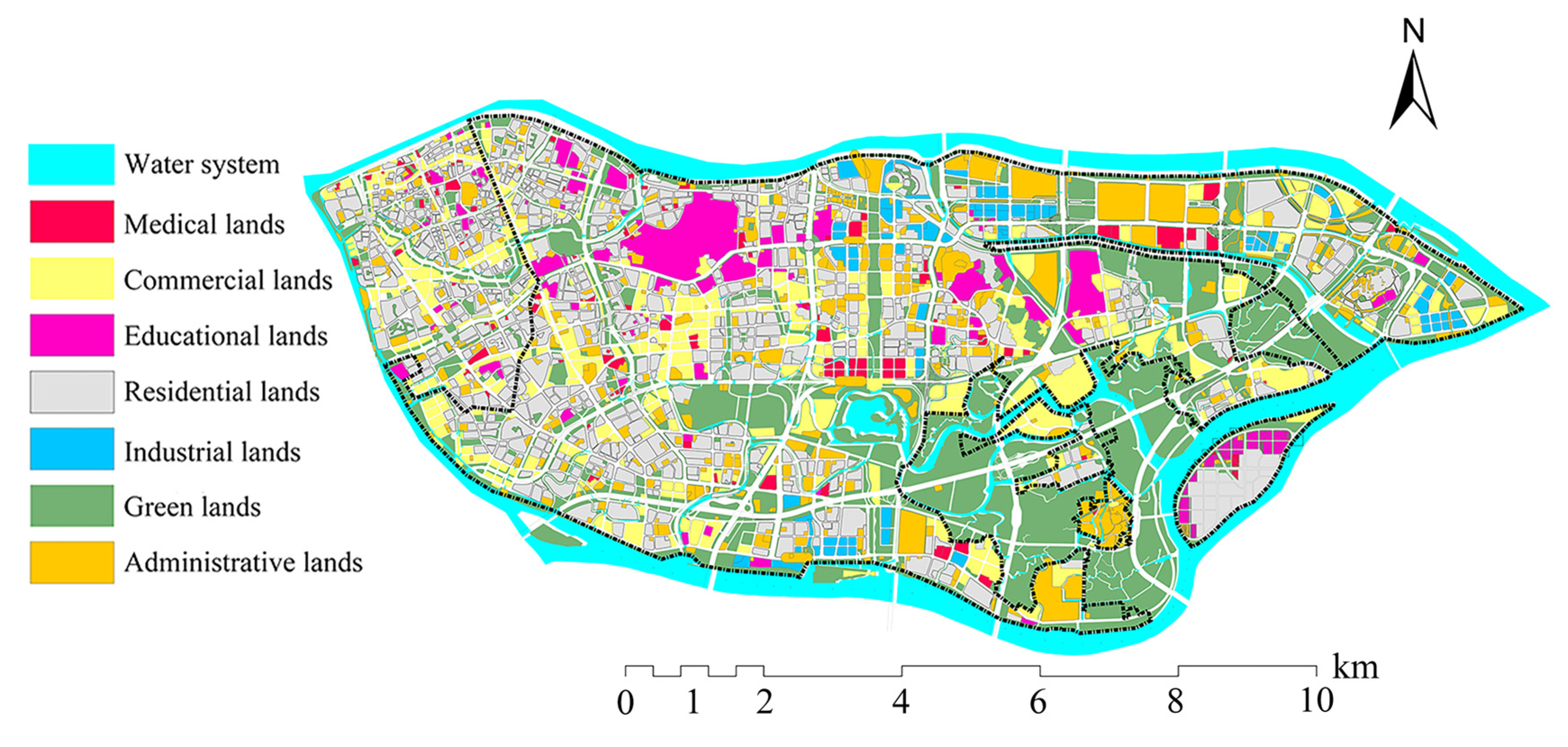

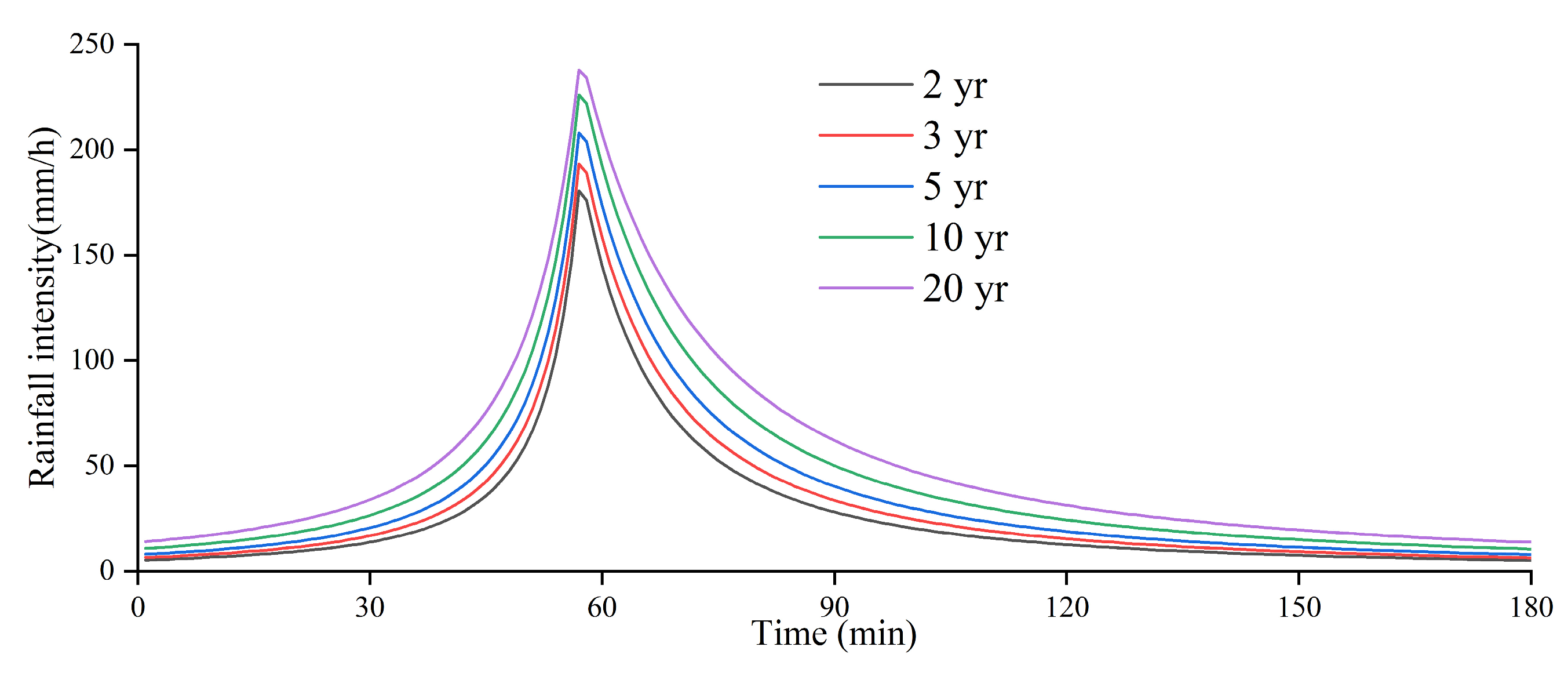



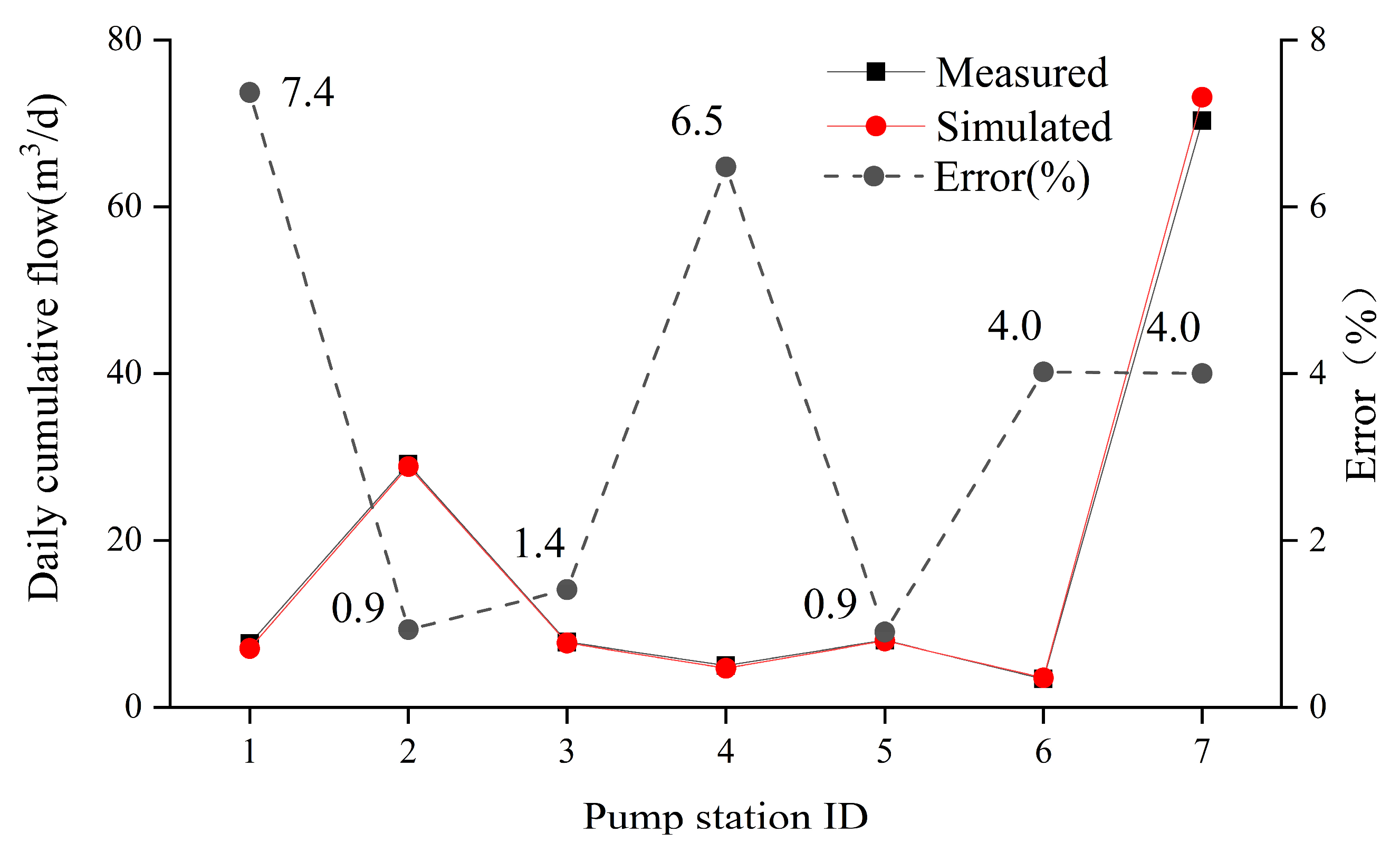


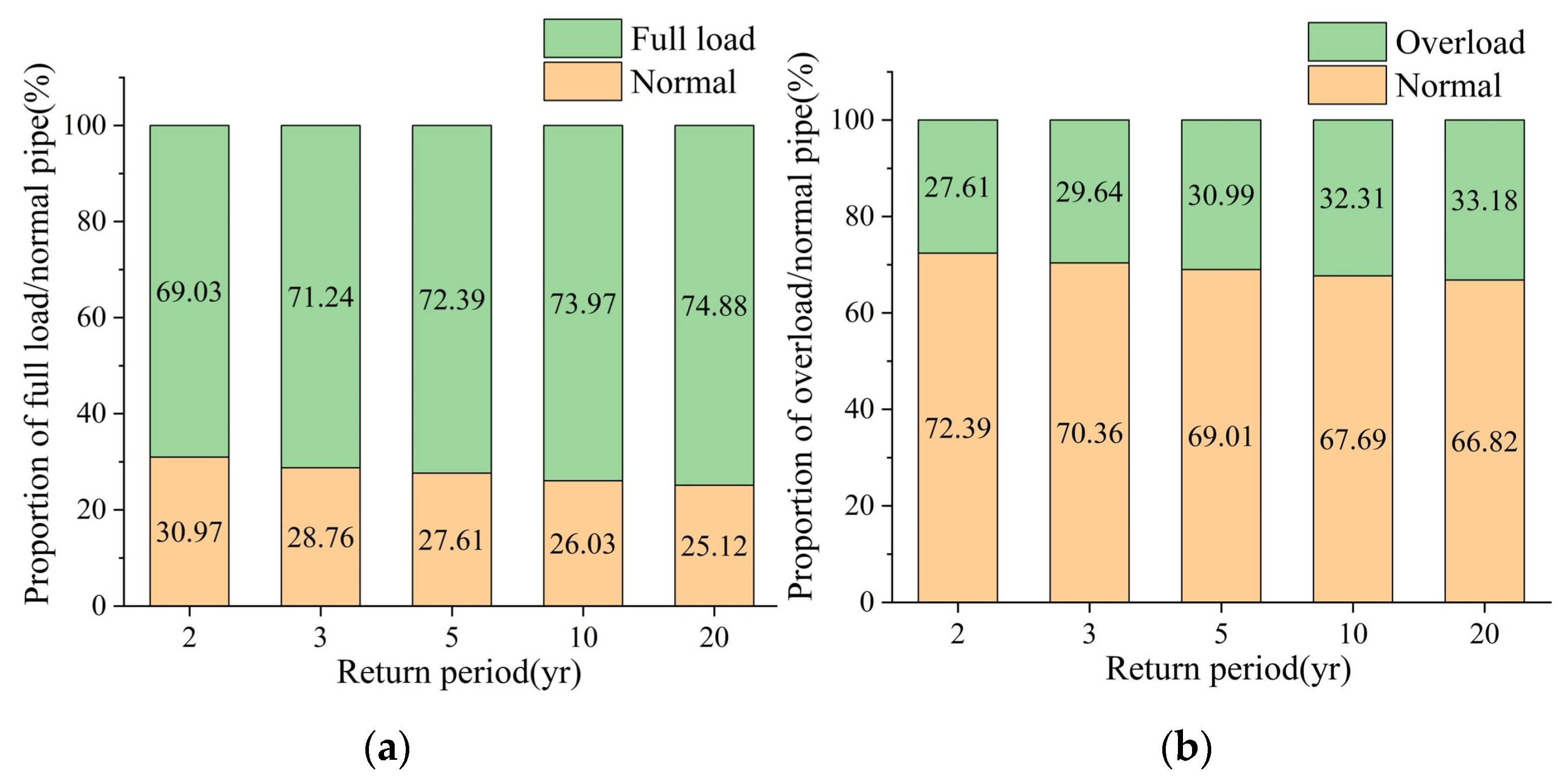




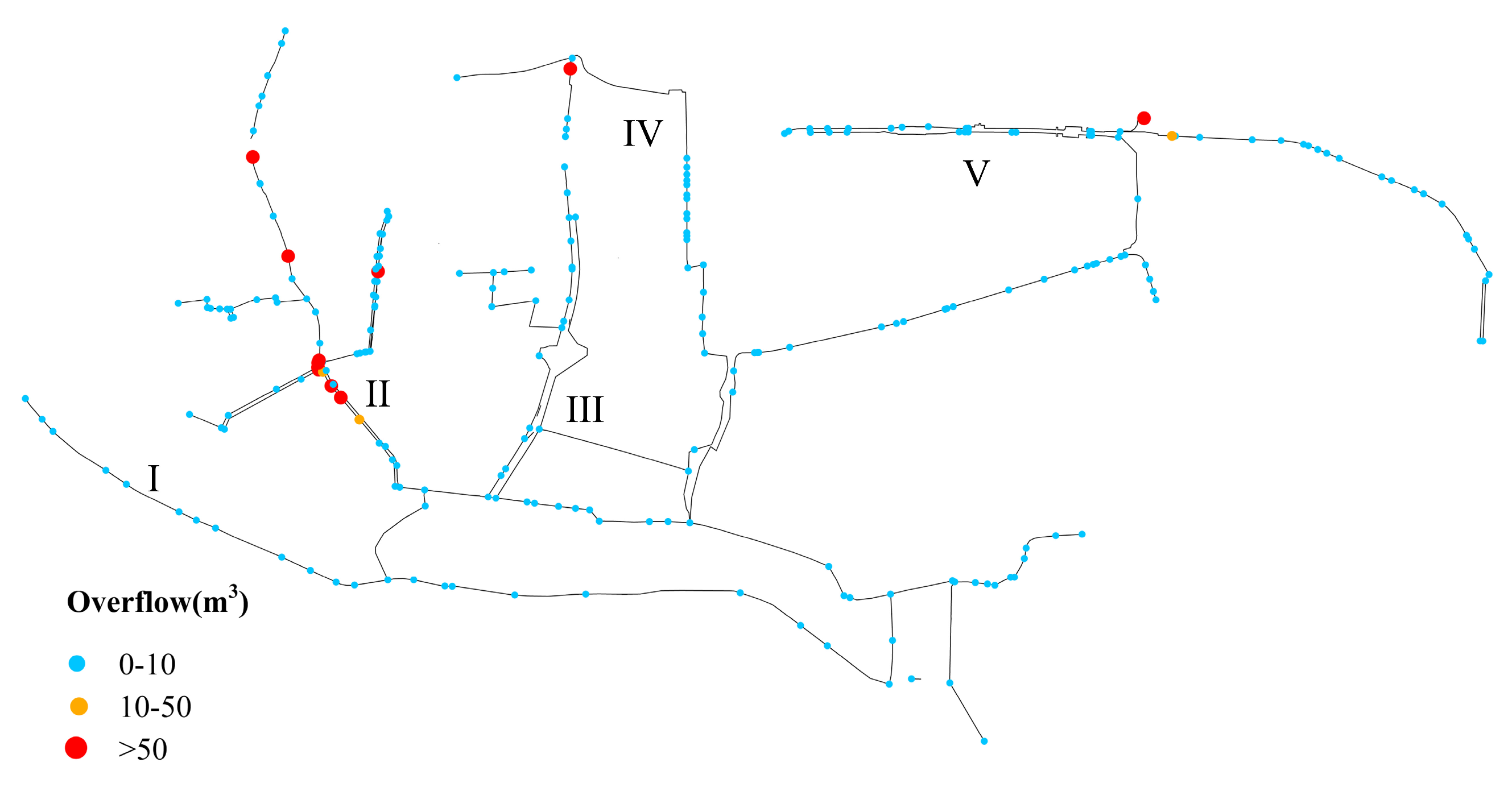
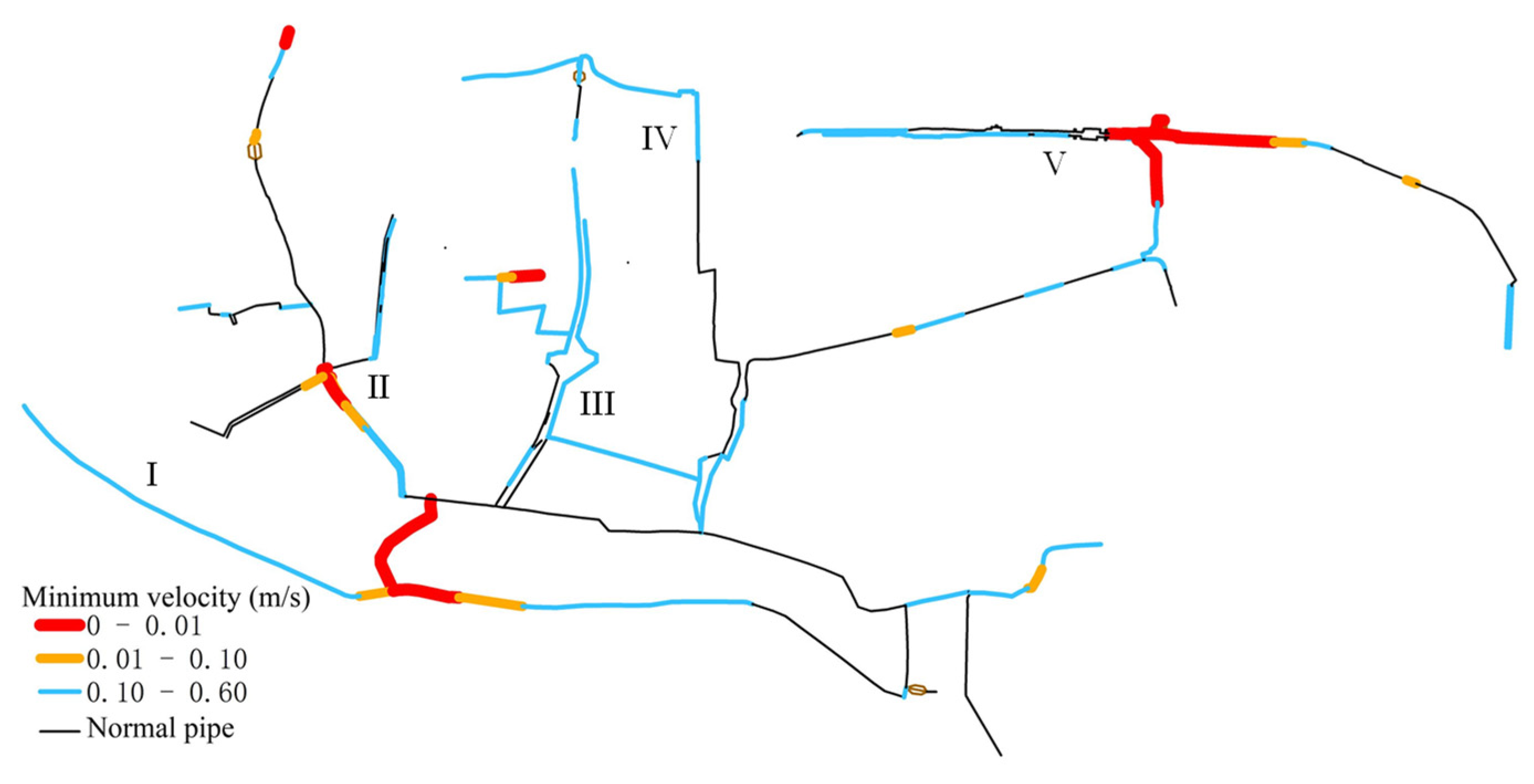
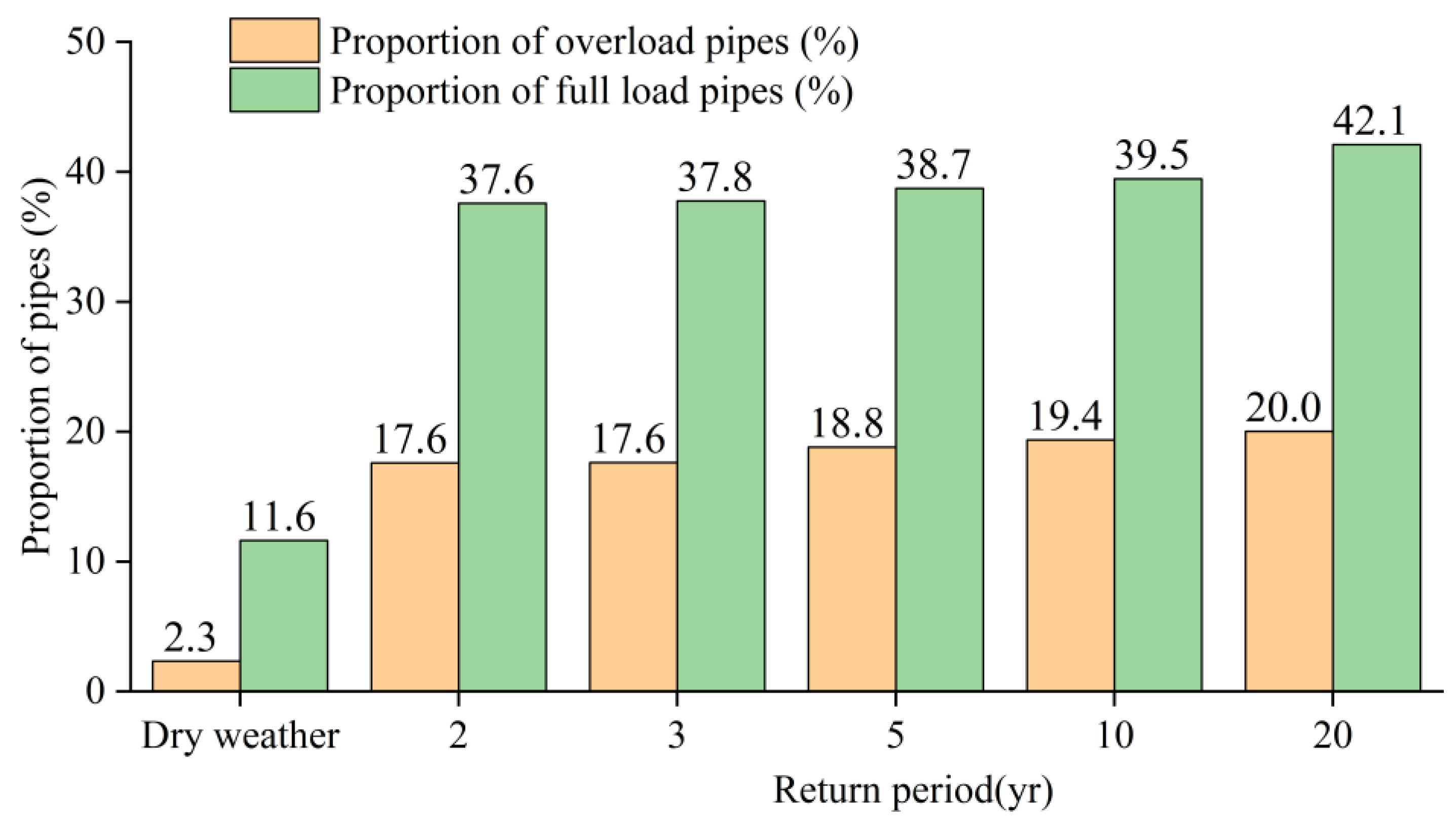



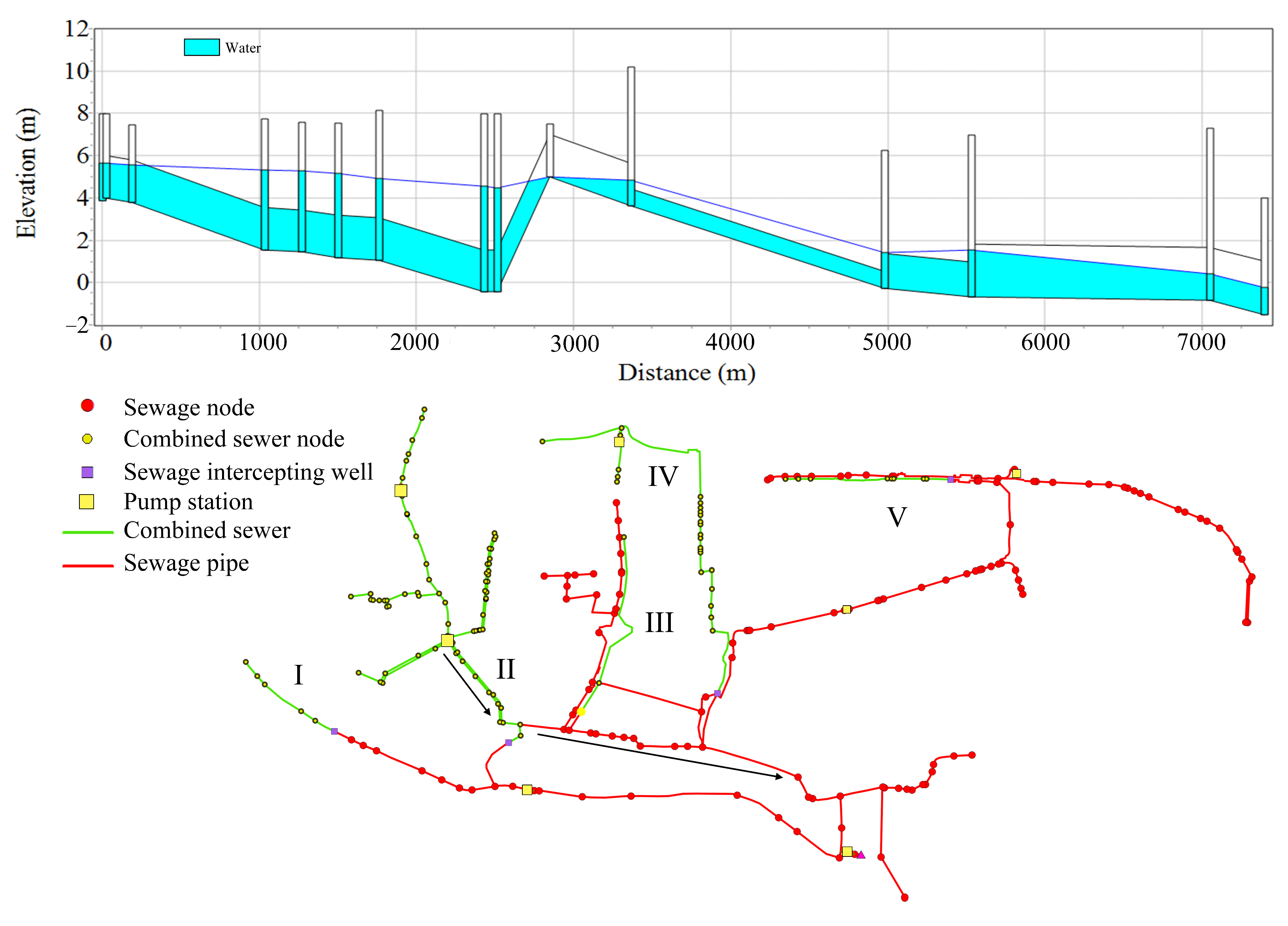
| Pipe Status | Meaning | Graphical Representation |
|---|---|---|
| full load | The water level either upstream or downstream of the pipe attains the upper limit of the pipe height | 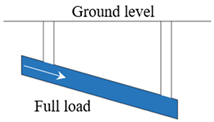 |
| overload | The water level exceeds the diameter of the pipe either upstream or downstream, and the hydraulic gradient exceeds pipe slope. |  |
| overflow | An overflow occurred in the node of the pipeline. | 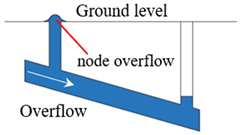 |
| low velocity | Sediment accumulation occurs due to the slow flow velocity |  |
| Amount | Return Period | |||||
|---|---|---|---|---|---|---|
| Node Overflow (×103 m3) | 2 yr | 3 yr | 5 yr | 10 yr | 20 yr | |
| <1 | 2572 | 2612 | 2654 | 2706 | 2724 | |
| 1–10 | 402 | 503 | 624 | 770 | 916 | |
| 10–20 | 14 | 16 | 20 | 27 | 44 | |
| >20 | 10 | 12 | 15 | 22 | 29 | |
| Total | 2998 | 3143 | 3313 | 3525 | 3713 | |
Disclaimer/Publisher’s Note: The statements, opinions and data contained in all publications are solely those of the individual author(s) and contributor(s) and not of MDPI and/or the editor(s). MDPI and/or the editor(s) disclaim responsibility for any injury to people or property resulting from any ideas, methods, instructions or products referred to in the content. |
© 2024 by the authors. Licensee MDPI, Basel, Switzerland. This article is an open access article distributed under the terms and conditions of the Creative Commons Attribution (CC BY) license (https://creativecommons.org/licenses/by/4.0/).
Share and Cite
Li, W.; Wang, Z.; Zhou, J.; Pang, Y.; Wang, H. Operation Risk Simulation and Interaction Impact of Stormwater and Sewage Systems Based on Storm Water Management Model. Water 2024, 16, 953. https://doi.org/10.3390/w16070953
Li W, Wang Z, Zhou J, Pang Y, Wang H. Operation Risk Simulation and Interaction Impact of Stormwater and Sewage Systems Based on Storm Water Management Model. Water. 2024; 16(7):953. https://doi.org/10.3390/w16070953
Chicago/Turabian StyleLi, Wentao, Zijian Wang, Jinjun Zhou, Yali Pang, and Hao Wang. 2024. "Operation Risk Simulation and Interaction Impact of Stormwater and Sewage Systems Based on Storm Water Management Model" Water 16, no. 7: 953. https://doi.org/10.3390/w16070953






